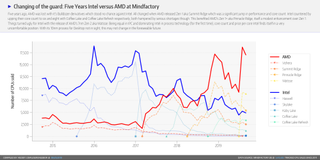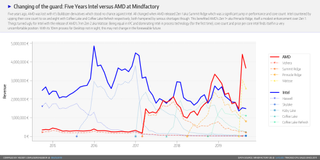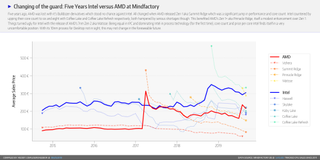AMD Comes Roaring Back: Analyzing Five Years of CPU Sales at Mindfactory
It's well known at this point that Ryzen is fueling AMD's rise against Intel in the do-it-yourself PC market. We recently reported on the effect Ryzen 3000 had on AMD's sales at Mindfactory, one of Germany's most popular internet retailers, and now reddit user ingebor (who has compiled all of the Mindfactory data we've covered thus far) has charted sales data over the past five years that provides an incredible overview of AMD's rise since 2017.

In the middle of 2014, Intel sold ~12,000 CPUs compared to AMD's roughly 4,000 processors, giving Intel a hefty 75% control of the market and leaving AMD with a measly 25%. Unfortunately for AMD, things got even worse in 2015 (as many are aware) because of two major reasons: firstly, AMD was still on its 2012 architecture Vishera, which powered second-gen FX CPUs (like the 8350), and secondly, Intel was soon to release its Skylake CPUs fabricated on the then-new 14nm process. The chips clocked rather well, dropped into more modern motherboards, and introduced DDR4 memory support.
Vishera, having been defeated already by Ivy Bridge and Haswell in 2012 and 2013, provided no challenge to Skylake-powered 6th-gen CPUs, whose main competitor was not AMD's FX series, but Intel's own 4th-gen CPUs. The results were disastrous for AMD, which immediately fell well below 20% share and perhaps even dipped as low as 15% share at the beginning of 2016. The gap appeared to close in 2015 and 2016, right up until the end of 2016 when Intel put AMD back below 20% share once again thanks to increasingly good sales.
However, this victory was somewhat short-lived for Intel, because, as we all know, AMD had been cooking something up for many years: the Zen microarchitecture.
Ryzen launched in early 2017, and it didn't take long for AMD to reverse Intel's gains. By mid-2017 AMD had achieved parity with Intel in terms of market share and even revenue; Ryzen 1000-series processors became the most popular chips at Mindfactory. AMD was just about to overtake Intel outright when the 8th-gen (Coffee Lake) CPUs launched. Coffee Lake provided some reprieve for Intel, and 8th-gen CPUs quickly slowed down AMD's momentum and took back the lead in terms of both sales and revenue. However, it wasn't long before AMD gave its response in the form of the Ryzen 2000 chips based on Pinnacle Ridge.
Despite being a modest refresh of Zen, Pinnacle Ridge propelled AMD into first place. Despite Coffee Lake's impressive performance, it took almost no time at all for AMD to soar into first place in sales. Near the end of 2018, AMD had two-thirds of the market despite the Coffee Lake refresh, spearheaded by the eight-core Core i9-9900K having launched around this time. AMD also managed to take the revenue crown, but just barely because Ryzen 2000 was mostly popular due to its lower pricing than Ryzen 1000-series processors, a move that proved to be crucial to success.

When we look at the recent sales data on Matisse, the architecture that powers Ryzen 3000, it seems like AMD has the best of both world's right now. Unlike with Pinnacle Ridge, both sales and revenue are very high. The volume ramp might actually be the most surprising aspect; it took Ryzen 2000 half a year to sell as many CPUs per day as Ryzen 3000 did the day it launched. Ryzen 2000 remains popular, however, landing just below Ryzen 3000 chips.
Stay on the Cutting Edge
Join the experts who read Tom's Hardware for the inside track on enthusiast PC tech news — and have for over 25 years. We'll send breaking news and in-depth reviews of CPUs, GPUs, AI, maker hardware and more straight to your inbox.
Ryzen 3000's average selling price is also an interesting figure: From 2014 to early 2017, AMD CPUs sold for 100 Euros on average, and Intel CPUs retailed for about 250. When Ryzen 1000 launched, AMD's average sale price also shot up to around 250 Euros, and then slowly declined to around 170 Euros until Ryzen 3000 launched. The new Ryzen chips brought AMD back up to about 250 again (though it is falling close to 200 now). Intel, on the other hand, has been increasing its average selling price since late 2017, from 250 to 300 Euros today, with a peak of 350 Euros in late 2019 due to the Coffee Lake refresh.

Though this data might not reflect the sales data of other retailers of other countries or even other German retailers, it's highly likely other retailers are seeing higher than normal AMD sales and lower than normal Intel sales, even if Intel is still the market leader. We're very excited to see these interesting developments in the CPU space, competition is good for the consumer, and we're looking forward to the next round of competition as Intel and AMD are both poised to make big launches in both the HEDT and mainstream segments before the end of the year.
Matthew Connatser is a freelancing writer for Tom's Hardware US. He writes articles about CPUs, GPUs, SSDs, and computers in general.
-
kinggremlin I find it really surprising there hasn't been more of a bloodbath at Intel in upper management based on the disastrous last 5 years. You can only be smug for so long without doing anything when you're on top before everyone realizes the competition has passed you. They've gone no where in 4 years since Skylake was released, and roadmaps indicate they're not going to go anywhere until 2021. We're looking at 6 years on the same architecture and node. It's practically unfathomable for a company with the resources of Intel that they have screwed up this bad and couldn't have headed this off at an earlier point.Reply
Intel is lucky that AMD was so buried when this started. It took 4 years of nothing for AMD to catch Intel. They're clearly going to pass them in all performance metrics in the next couple of years, while Intel continues to be stuck in 14nm hell. I can't believe that no one has been held accountable for this debacle and they just continue to listlessly drift along acting like the competition hasn't caught up and everything is going great. -
NightHawkRMX From what I see, even first-generation ryzen CPUs tie coffe lake refresh in sales numbers.Reply
Ow. -
TerryLaze Reply
I'm sorry but I don't understand,what's disastrous about having growth in a market that was prognosed to be stagnant at best?kinggremlin said:I find it really surprising there hasn't been more of a bloodbath at Intel in upper management based on the disastrous last 5 years. You can only be smug for so long without doing anything when you're on top before everyone realizes the competition has passed you. They've gone no where in 4 years since Skylake was released, and roadmaps indicate they're not going to go anywhere until 2021. We're looking at 6 years on the same architecture and node. It's practically unfathomable for a company with the resources of Intel that they have screwed up this bad and couldn't have headed this off at an earlier point.
Intel is lucky that AMD was so buried when this started. It took 4 years of nothing for AMD to catch Intel. They're clearly going to pass them in all performance metrics in the next couple of years, while Intel continues to be stuck in 14nm hell. I can't believe that no one has been held accountable for this debacle and they just continue to listlessly drift along acting like the competition hasn't caught up and everything is going great.
Intel is making money which is all that a company has to do.
All that intel had to do to stay ahead was to add cores and that's what they did.
Intel is still faster per core at everything we are still waiting on AMD to just get close. -
Loadedaxe Replykinggremlin said:I find it really surprising there hasn't been more of a bloodbath at Intel in upper management based on the disastrous last 5 years. You can only be smug for so long without doing anything when you're on top before everyone realizes the competition has passed you. They've gone no where in 4 years since Skylake was released, and roadmaps indicate they're not going to go anywhere until 2021. We're looking at 6 years on the same architecture and node. It's practically unfathomable for a company with the resources of Intel that they have screwed up this bad and couldn't have headed this off at an earlier point.
Intel is lucky that AMD was so buried when this started. It took 4 years of nothing for AMD to catch Intel. They're clearly going to pass them in all performance metrics in the next couple of years, while Intel continues to be stuck in 14nm hell. I can't believe that no one has been held accountable for this debacle and they just continue to listlessly drift along acting like the competition hasn't caught up and everything is going great.
I am sorry to burst your "someone needs fired at Intel" bubble. The sky is not falling.
AMD has not surpassed Intel. Intel is still faster than Zen even at 14nm+++++.
AMD is catching up, and its about time. But they don't deserve a medal for it. It took them 9 years. -
NightHawkRMX Reply
They dont get a medal, but they do get intel crushing sales.Loadedaxe said:But they don't deserve a medal for it. It took them 9 years.
And intel didnt improve a lot over 9 years, so they are now seeing the effects of that. -
TerryLaze Reply
No they don't.NightHawkRMX said:but they do get intel crushing sales.
The only store ... in the whole world ... that has better AMD than Intel sales is this one store we all hear about every now and then.
One store in the whole world does not equal crushing ... anything.
In the last quarter AMD made about 1,5 billion compared to intels 16,5...
http://quarterlyearnings.amd.com/financial-information/quarterly-results
http://quarterlyearnings.amd.com/static-files/33ed4154-376e-4edb-9690-4bdab97e2776
https://www.intc.com/investor-relations/investor-education-and-news/investor-news/press-release-details/2019/Intel-Reports-Second-Quarter-2019-Financial-Results/ -
Shumok ReplyTerryLaze said:I'm sorry but I don't understand,what's disastrous about having growth in a market that was prognosed to be stagnant at best?
Intel is making money which is all that a company has to do.
All that intel had to do to stay ahead was to add cores and that's what they did.
Intel is still faster per core at everything we are still waiting on AMD to just get close.
In these graphs, the line going down means that Intel's DIY sales and revenues are shrinking..not growing. Are you that confident that when the informed and knowledgeable users in the DIY market choose Ryzen, that this won't spill over into the other markets of less informed users as they get up to speed?
Being faster per core is not enough now. What matters is overall performance per dollar, and AMD wins here. The gaming advantage that Intel still has is insignificant with the GPU/res combination that most people play at, and when it does exist..it's usually at such high framerates it doesn't matter for most who know better. -
Shumok ReplyLoadedaxe said:I am sorry to burst your "someone needs fired at Intel" bubble. The sky is not falling.
AMD has not surpassed Intel. Intel is still faster than Zen even at 14nm+++++.
AMD is catching up, and its about time. But they don't deserve a medal for it. It took them 9 years.
You are wrong. AMD is now generally faster than Intel at most price points. Not to mention all of the other advantages. I'm guessing that the 'faster' that you meant, is the low res/extreme high end GPU gaming scenario that almost never impacts real user experience because AMD is already so fast there. -
refillable Mindfactory is a retailer for DIY PCs and while it's not the only DIY retailer in the world, it is enough to represent the DIY PC trend all around the world. However, the DIY market is small in terms of total PC revenue. For the DIY market, AMD will always have the advantage. AMD is a smaller company, so their mindshare would struggle to go through the mass population. This isn't a problem in the DIY market as they are mostly knowledgeable people. AMD also commits on sockets for much longer, which isn't really an advantage for most PC sellers. But, a 1.5 B increase of revenue on Intel is only a 10% increase, and 100% increase for AMD, and growth matters. In tech, having 10 times more revenue isn't going to get you anywhere if your product suck.Reply
Most Popular




